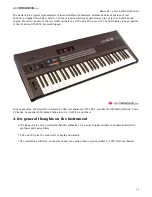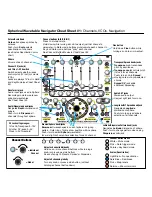
The first parameter applies a multiplier to the delay time, according to the following table:
Parameter value Multiplier Parameter value Multiplier Parameter value Multiplier
-15
1/64
-7
3/16
1
x1.5
-14
1/48
-6
1/4
2
x2
-13
1/32
-5
5/16
3
x3
-12
1/24
-4
1/3
4
x4
-11
1/16
-3
3/8
5
x5
-10
1/12
-2
1/2
6
x6
-9
1/8
-1
3/4
7
x8
-8
1/6
0
x1
8
x16
B-5 LFO
X is Hz/V frequency
Y is waveshape
Z is tune
A is saw -> sine -> triangle
B is pulse -> square -> pulse
Parameter Min Max Default
Description
0
0
40
32
Sets an attenuation for output A.
1
0
40
32
Sets an attenuation for output B.
2
-40 40
0
Sets an offset for output A.
3
-40 40
0
Sets an offset for output B.
4
-32 32
0
Y offset.
Outputs A & B are LFOs (low frequency oscillators), with CV control of frequency and waveshape.
The output signals are ±8V (16V peak-to-peak) by default, but can be attenuated via the parameters.
The outputs can also have a DC offset applied. The offset in Volts is (parameter value)/4 i.e. the
range is ±10V, in steps of 0.25V.
Input X is a Hz/V frequency control, scaled at 1Hz/V. Note that the input is allowed to go negative,
resulting in a phase-reversed output.
Knob/CV Z is a tuning control, with a range of approximately ±10Hz. This is simply added to the
setting from input X (so with input X disconnected, the knob can be used to manually set an LFO
rate).
Input Y controls the waveshape of the output signals. Signals in the range ±5V give the full range of
possible waveshapes:
Input Y
-5V
0V
+5V
Output A
saw
sine
triangle
Output B
0% duty cycle pulse
50% duty cycle pulse
(square)
100% duty cycle pulse
Parameter 4 offsets the Y input, providing a way to set the waveshape manually.
Page 29
















































